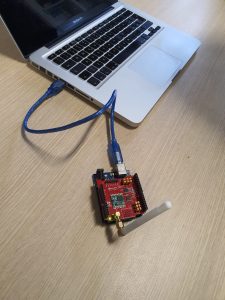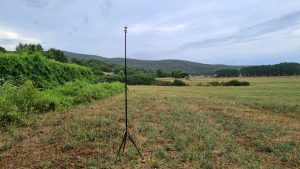The Project SPRINT at University of Siena
SPRINT, “Supporting Project to Restart on Intelligent Networks for Telecommunications”, is the name of the winning project of a cascade call of the NetWIN project of the Italian PNRR program, on which a team of researchers from the Department of Information Engineering and Mathematics together with of the Department of Physical Sciences, Earth and Environment are working.

We asked Professor Giovanni Giambene, coordinator of the project for the University of Siena, to tell us about their work.
From what context did the research idea arise?
“The increasing technical innovations of the last few years – Giambene explains – have allowed new opportunities and applications for the Internet of Things (IoT), and the advent of Low Power Wide Area Network (LPWAN) technologies has facilitated massive use of IoT nodes. IoT can improve sustainability and give farms an economic return of up to 25% of the harvest in smart agriculture. The UN states that food production will need a 70% increase for the sustainability of the global population, which is expected to cross the nine billion people by 2050”.
“Nowadays – Giambene continues – many sensors are used for smart agriculture applications, and the trend is increasing. For instance, moisture sensor monitoring is particularly useful in understanding irrigation needs: when soil moisture is below a certain level, water can be provided by activating local irrigation actuators connected with sensor nodes, allowing more efficient irrigation and sustainability and reducing human intervention”.

What critical issues and solutions have been identified?
“When IoT devices are deployed in remote and rural areas – Giambene says – a significant criticality is the lack of Internet connectivity and local power supply. This issue can be overcome by adopting LPWAN, where data are collected by a gateway onboard a drone, the so-called Unmanned Aerial Vehicle (UAV). The UAV is envisaged to periodically pass over the IoT sensors’ area to collect data measurements and forward them to the Internet. Although there are several LPWAN technologies, we focus in this project is on LoRa because this low-power communication technology can allow devices to communicate with other nodes kilometers away, lasting several years without battery replacements. Furthermore, LoRa allows working on an open-source Medium Access Control (MAC) layer (specified as LoRaWAN) to implement new protocol solutions and specific scenario-based upgrades”.
In particular, what does the work of the University of Siena group focus on?
“The UNISI activity is divided into two parts” – Giambene explains. “First of all, we are focusing on improving the access of IoT devices communicating with flying UAVs, taking propagation, collisions of simultaneous transmissions, and channel impairments into account. The problem with LoRa/LoRaWAN transmissions is that they have been designed to allow the communication of sensors under permanent coverage of the gateway. Therefore, we need protocol adaptations and a suitable approach to manage the occasional

availability of the UAV to cover the sensors. Solutions are under investigation to schedule IoT transmissions, activate IoT nodes via beacons, and improve access efficiency. Then, a second part of the activity deals with the use of Artificial Intelligence (AI) onboard the UAV to elaborate data on the fly and infer the needs of the crop based on sensor data received and pictures taken onboard. The LoRa gateway and the LoRa server are based on open-source code that the UNISI has modified to handle the access with better energy efficiency. Sensor battery lifetime can be improved by the adoption of such LPWAN technologies. In addition to this, small solar panels can be used to recharge the sensors’ batteries, thus allowing a lifetime of 5 to 10 years”.
“We consider – Giambene continues – multiple UAVs that can communicate with each other and are equipped with different devices so that they can collect a diverse set of data (images and IoT data from the ground). This information can be elaborated onboard using a federated learning AI approach that combines the knowledge acquired by the different UAVs without the need to share the data acquired in the network for privacy reasons. The radio channel is used efficiently because only model coefficients are exchanged. Ad hoc networking among UAVs is adopted”.

“University of Siena’ team – Giambene concludes – will also contribute to a demonstrator where UAVs collect data from the ground IoT devices via LoRa/LoRaWAN radio link. The UAVs will communicate directly with each other via WiFi so that they will be able to operate the federated learning approach for the different types of data collected. The UAV flight has to be compliant with the regulations of Italian Civil Aviation Authority (ENAC) and the European Union Aviation Safety Agency (EASA)”.
Alessandro Andreadis, Andrea Garzelli, Giovanni Giambene, Muhammad Pathan, Riccardo Salvini, Franco Scarselli, Tinh Vo, and Riccardo Zambon are members of the University of Siena research team. The Laboratory involved is the Telecommunications and Telematics lab of the department of Information Engineering and Mathematics.
Framework: Cascade call of the NetWIN project (https://www.fondazione-restart.it/projects/s3- netwin/) of the program RESTART – RESearch and innovation on future Telecommunications systems and networks, to make Italy more smART – PIANO NAZIONALE DI RIPRESA E RESILIENZA (PNRR)
Partners: University of Salerno (prime), University of Genoa, University of L’Aquila, University of Milan-Bicocca, University of Palermo, University of Perugia, University of Pisa, University of Siena, University of Trento, Anritsu srl, Fastweb spa, Logogramma srl, Maticmind spa, Nextworks, Sensor-ID srl, Unidata spa.
Contact: giavanni.giambene@unisi.it

